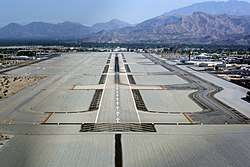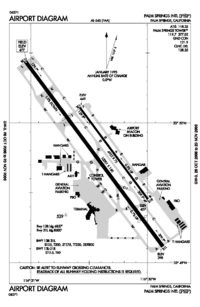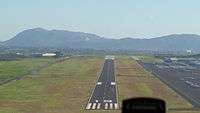Palm Springs International Airport
Palm Springs International Airport (IATA: PSP, ICAO: KPSP, FAA LID: PSP), formerly Palm Springs Municipal Airport, is an airport two miles (3 km) east of downtown Palm Springs, California. The airport covers 940 acres (380 ha) and has two runways.[2] The facility operates year-round, with most flights occurring in the fall, winter, and spring.
Palm Springs International Airport Palm Springs Army Airfield | |||||||||||||||
|---|---|---|---|---|---|---|---|---|---|---|---|---|---|---|---|
 | |||||||||||||||
| Summary | |||||||||||||||
| Airport type | Public | ||||||||||||||
| Owner | City of Palm Springs | ||||||||||||||
| Operator | City of Palm Springs Aviation Department | ||||||||||||||
| Serves | Coachella Valley Inland Empire | ||||||||||||||
| Location | Palm Springs, California | ||||||||||||||
| Elevation AMSL | 476 ft / 145 m | ||||||||||||||
| Coordinates | 33°49′47″N 116°30′24″W | ||||||||||||||
| Website | Official website | ||||||||||||||
| Maps | |||||||||||||||
 FAA diagram | |||||||||||||||
 PSP  PSP | |||||||||||||||
| Runways | |||||||||||||||
| |||||||||||||||
| Statistics (2019) | |||||||||||||||
| |||||||||||||||
The airport was described as number 3 in a 2011 listing of "America's Most Stress-Free Airports" by Smarter Travel.[3]
History
Military use
PSP was built as a United States Army Air Corps emergency landing field in 1939 on land owned by the Agua Caliente Band of Cahuilla Indians due to its clear weather and its proximity to March Field and the Los Angeles area.
In March 1941 the War Department certified improvements to the existing airport in Palm Springs as essential to National Defense. The airport was approved to serve as a staging field by the Air Corps Ferrying Command 21st Ferrying Group in November 1941. Land was acquired to build a major airfield a half mile from the old airfield site. The new airfield, Palm Springs Army Airfield[4] was completed in early 1942, and the old air field was then used only as a backup. (Aerial pic of the old airfield at 33.827°N 116.533°W, looking ENE)
Many of the field's Air Transport Command 560th Army Air Forces Base Unit personnel stayed at the comfortable Lapaz Guest Ranch nearby. Training conducted at the airfield was by the 72d and 73d Ferrying Squadrons in long-distance over-water flying and navigation. Later, training was also provided to pursuit pilot training by IV Fighter Command 459th Base Headquarters and Air Base Squadron. Training was in P-51 Mustangs, P-40 Warhawks and P-38 Lightnings.
On June 1, 1944, training moved to Brownsville Army Airfield, Texas, and the airfield was used for Army and Navy transport flights until the end of April 1945. The auxiliary field or backup field was declared surplus on May 12, 1945, and the main airfield was declared excess and transferred to the War Assets Administration for disposal in 1946 and it was sold to private buyers. The City of Palm Springs purchased the land in 1961 and converted it to Palm Springs Municipal Airport.
Airline service
Palm Springs had scheduled passenger service in 1934 operated by Palm Springs Air Lines with Ford Trimotor aircraft with flights to the Union Air Terminal (now the Hollywood Burbank Airport) in Burbank.[5] Western Airlines flights began in 1945–46 followed by Bonanza Air Lines in 1957–58. In 1964 Western Lockheed L-188 Electras flew nonstop to Las Vegas, Los Angeles and San Diego.[6] Bonanza and successors Air West and Hughes Airwest served Palm Springs for many years with the Fairchild F-27 followed by Douglas DC-9s. American Airlines Boeing 707s appeared in winter 1967-68. By 1969 American had four Boeing 707 departures a day from the airport, two nonstops to Los Angeles and two nonstops to Phoenix and on to Chicago.[7] Trans World Airlines (TWA) Boeing 707s arrived in 1978, flying to Chicago via Phoenix.
Scheduled nonstops did not reach beyond California, Las Vegas, and Phoenix until winter 1969–70 when American Airlines started a nonstop to Chicago O'Hare Airport. In the 1970s American McDonnell Douglas DC-10s appeared, the largest aircraft ever scheduled to PSP. In 1976 American was flying the DC-10 to LaGuardia Airport via Chicago O'Hare Airport and Boeing 727-100s to Dallas/Fort Worth, Phoenix and Los Angeles.[8] In 1976 Western Boeing 727-200s and Boeing 737-200s flew nonstop to Las Vegas, Los Angeles and San Francisco.[8] In 1987 Western was merged into Delta Air Lines which continues to serve PSP seasonally. Other jets to Palm Springs in the past included Air21, Air California and successor Air Cal, America West Airlines, CP Air, the original Frontier Airlines (1950-1986), Hughes Airwest, Morris Air, Pacific Express, Pan Am, Reno Air, Republic Airlines (1979-1986) and USAir.[9]
Commuter and regional airlines at Palm Springs from the late 1970s to the 1990s included Air Bahia, Air Nevada, American Eagle operated by Wings West Airlines, America West Express operated by Mesa Airlines, Cable Commuter Airlines, California Seaboard Airlines, Dash Air, Delta Connection operated by SkyWest Airlines, Imperial Airlines, Inland Empire Airlines, Scenic Airlines, SkyWest Airlines (operating independently), Sun Aire Lines, Swift Aire Lines, Trans World Express operated by Alpha Air, United Express operated by WestAir and later by SkyWest Airlines, and USAir Express followed by US Airways Express operated by Trans States Airlines and StatesWest Airlines.[10]
Other past use
On December 30, 2006 a U.S. Air Force Presidential Boeing VC-25 (the USAF military version of the Boeing 747), departed Palm Springs International Airport with the body of the 38th President of the United States, Gerald R. Ford, and delivered it to Washington, D.C., for memorial services.
U.S. Customs clearance
Although a true international airport, PSP only has U.S. customs and immigration facilities for general aviation aircraft including business jets. All international airline flights are currently operated from Canadian cities that have pre-clearance facilities.
Terminals

(view as a 360° interactive panorama)
PSP's passenger terminal consists of three parts—the main building, the elevated Sonny Bono Concourse to the north, and a yet-unnamed concourse to the south.[11] Airside, it has a unique open-air layout in that all passenger walkways connecting these structures are roofless.[12]
Main Building
The main building is the land side of the airport. Road traffic accesses the airport directly off of Tahquitz Canyon Way (from downtown) or Kirk Douglas Way, itself fed by Ramon Road from points east. Uncovered parking areas are directly in front of the building. The center section houses the security screening area and automatic doors to/from the open-air walkways airside. Ticketing is on the right (south) wing, while baggage claim and car rental counters are on the left (north).
Departing passengers are routed first to airline ticket counters or kiosks for checking in. Since all gates at Palm Springs are in the two outlying concourses, passengers must pass through the security screening area for admittance into the secure air side of the airport. After leaving the main building via the automatic doors leading out to the open-air courtyard, passengers can access seventeen full-service gates at the two concourses.

Sonny Bono Concourse (Gates 4–11)
On November 4, 1999, the new Sonny Bono Concourse opened as part of the 1994–2000 expansion. Named in honor of the late singer, congressman and former mayor of the city,[13] this newer concourse is the elevated one of the two. It is used for larger aircraft (such as the Boeing 737) because of its jet bridges. SB's outdoor escalator and walkway are shaded by a designer roofline similar to that of the Denver International Airport. [12]
Airlines and destinations
.jpg)
.jpg)
.jpg)
.jpg)
.jpg)
Passenger
| Airlines | Destinations |
|---|---|
| Air Canada | Seasonal: Vancouver |
| Air Canada Rouge | Seasonal: Toronto–Pearson |
| Alaska Airlines | San Francisco, Seattle/Tacoma Seasonal: Everett, Portland (OR) |
| Allegiant Air | Bellingham |
| American Airlines | Dallas/Fort Worth Seasonal: Chicago–O'Hare |
| American Eagle | Phoenix–Sky Harbor |
| Contour Airlines | Seasonal: Sacramento |
| Delta Air Lines | Seasonal: Atlanta, Minneapolis/St. Paul, Seattle/Tacoma |
| Delta Connection | Salt Lake City |
| Frontier Airlines | Seasonal: Chicago–O'Hare, Denver |
| JetBlue | Seasonal: Boston, New York–JFK |
| Sun Country Airlines | Seasonal: Dallas/Fort Worth, Minneapolis/St. Paul, San Francisco |
| United Airlines | Denver, San Francisco Seasonal: Chicago–O'Hare, Houston–Intercontinental |
| United Express | Denver, Los Angeles, San Francisco Seasonal: Chicago–O'Hare, Houston–Intercontinental |
| WestJet | Calgary, Vancouver Seasonal: Edmonton, Winnipeg |
Cargo
| Airlines | Destinations |
|---|---|
| Ameriflight | Ontario |
Statistics
Top destinations
| Rank | City | Passengers | Carriers |
|---|---|---|---|
| 1 | San Francisco, California | 161,000 | Alaska, Sun Country, United |
| 2 | Seattle/Tacoma, Washington | 133,000 | Alaska, Delta |
| 3 | Phoenix–Sky Harbor, Arizona | 109,000 | American |
| 4 | Dallas/Fort Worth, Texas | 102,000 | American, Sun Country |
| 5 | Denver, Colorado | 89,000 | Frontier, United |
| 6 | Portland, Oregon | 52,000 | Alaska, Sun Country |
| 7 | Chicago–O'Hare, Illinois | 51,000 | American, Frontier, United |
| 8 | Salt Lake City, Utah | 44,000 | Delta |
| 9 | Minneapolis/St. Paul, Minnesota | 37,000 | Delta, Sun Country |
| 10 | Houston-Intercontinental, Texas | 22,000 | United |
Ground transportation
State Route 111 (Gene Autry Trail) is accessible to PSP via Ramon Road.
PSP is served by both municipal and regional routes. Sunline's SunBus route 24 provides direct service to downtown Palm Springs via the bus stops at El Cielo/Kirk Douglas and Tahquitz/Civic. Morongo Basin Transit Authority provides service to Twentynine Palms. An Amtrak Thruway bus stop is located just outside the baggage claim area, with service to Cabazon (Morongo Casino), Riverside, and Fullerton.
See also
- California World War II Army Airfields
- Air Transport Command
- Palm Springs Air Museum
References
![]()
- "PSP Statistical Data". City of Palm Springs. January 2019. Retrieved April 25, 2019.
- FAA Airport Master Record for PSP (Form 5010 PDF), effective June 21, 2018.
- "America's Most Stress-Free Airports". SmarterTravel.com. April 5, 2011.
- U.S. Geological Survey Geographic Names Information System: Palm Springs Army Air Field (historical)
- http://www.timetableimages.com, Dec. 20, 1934 Palm Springs Air Lines timetable
- http://www.timetableimages.com, March 1, 1964 Western timetable
- http://www.departedflights.com, Mar. 30, 1969 American timetable
- Feb. 1, 1976 Official Airline Guide
- http://www.departedflights.com, Route Maps
- http://www.departedflights.com, Official Airline Guide editions: Nov. 15, 1979; April 1, 1981; Feb. 1, 1985; April 2, 1995; June 1, 1999
- "Archived copy". Archived from the original on January 23, 2013. Retrieved November 25, 2013.CS1 maint: archived copy as title (link)
- "Terminal Map | City of Palm Springs". www.palmspringsca.gov. Retrieved March 22, 2020.
- "Airport Adds Sonny Bono Concourse". Billboard.
- Research and Innovative Technology Administration (RITA). "Palm Springs, CA: Palm Springs International (PSP) Scheduled Services except Freight/Mail". U.S. Department of Transportation (US DOT). Retrieved July 30, 2020.
External links
| Wikimedia Commons has media related to Palm Springs International Airport. |
- Palm Springs International Airport (official site)
- Signature Flight Support
- FAA Airport Diagram (PDF), effective August 13, 2020
- Resources for this airport:
- AirNav airport information for KPSP
- ASN accident history for PSP
- FlightAware airport information and live flight tracker
- NOAA/NWS weather observations: current, past three days
- SkyVector aeronautical chart for KPSP
- FAA current PSP delay information

